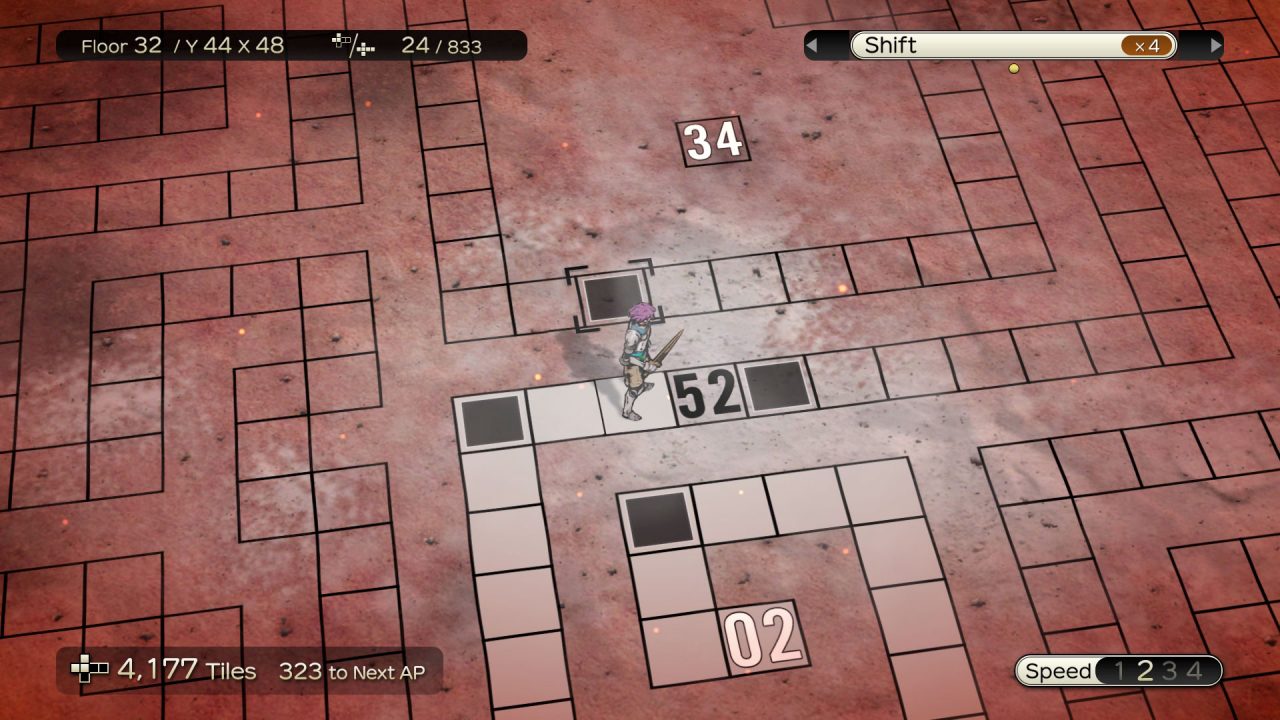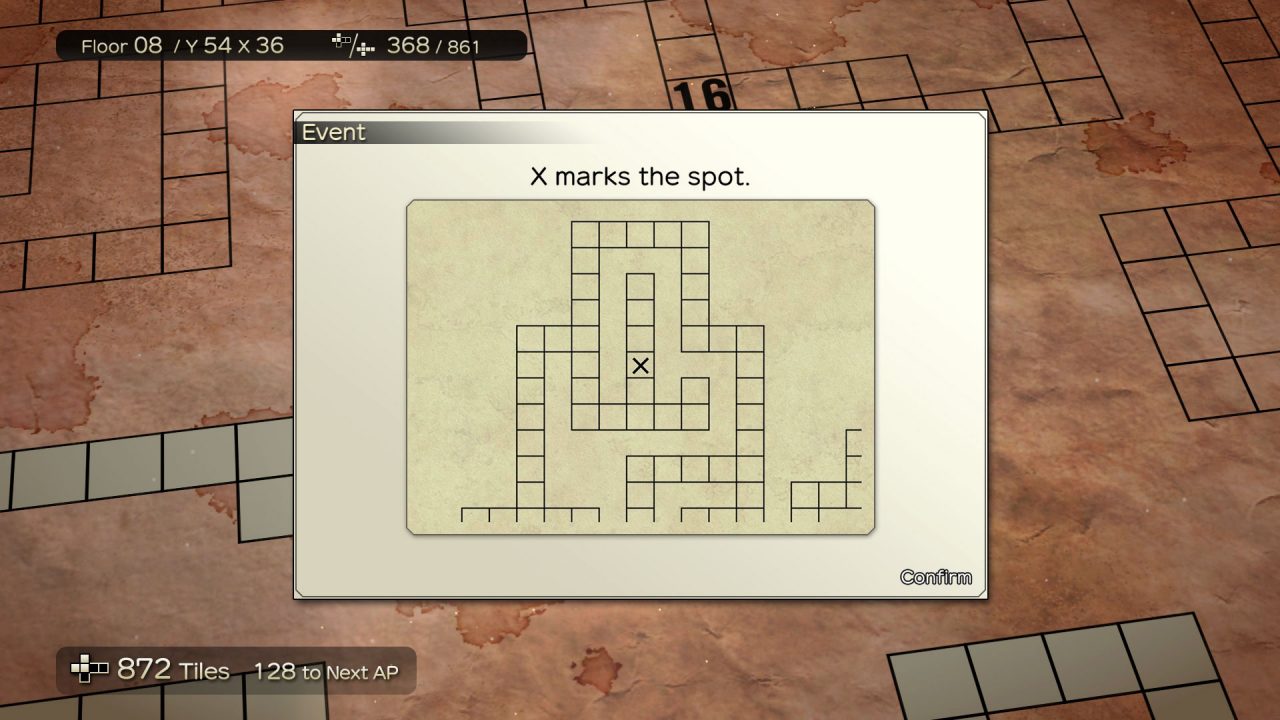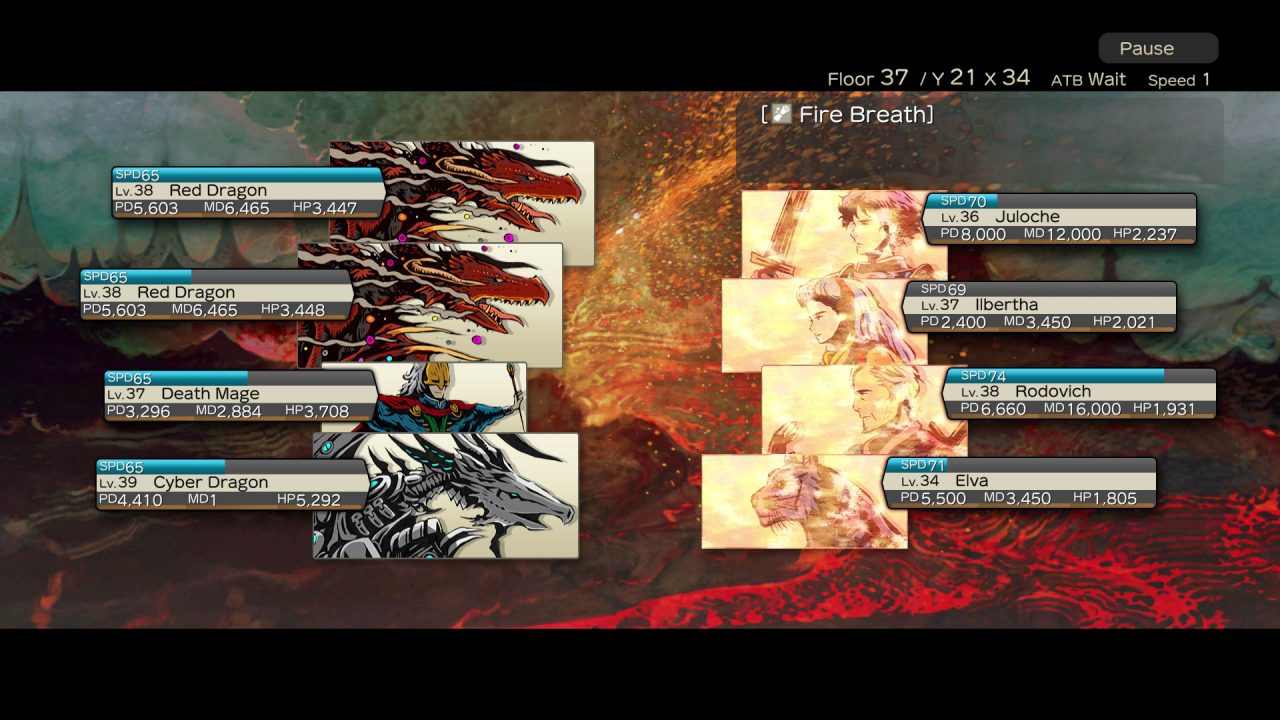Hiroyuki Ito has directed some of Square Enix’s most beloved games, including Final Fantasy VI, IX, and XII. Final Fantasy XII debuted 15 years ago, so it was quite the surprise when Dungeon Encounters was announced just two short weeks before its release with Ito at the helm. With Dungeon Encounters, Ito and his team have made something undeniably strange that’s also unusually charming.
Dungeon Encounters is minimalist in every sense, to the extent it is easy to suspect it of being a prototype or of having had an exceedingly low budget. However, its sheer dedication to minimalism suggests a deliberate design decision. Aesthetically, Dungeon Encounters is a dungeon-crawling JRPG boiled down to its essentials. The entirety of the game exists within straightforward menus and grid-based maps. Even the battle screen just shows static art of the characters and monsters with the occasional overlay of a simple attack animation.
The premise of Dungeon Encounters is no exception to its commitment to minimalism and is almost completely captured within a single opening paragraph — a magical labyrinth has sprung up near a town, and the townsfolk are determined to conquer said labyrinth. After reading this memo, you are set loose; your only direction is to reach the bottom of the 99-floor dungeon. You begin on floor 00, which is the town, where you can form your party, buy goods, and prepare for the fight ahead.
There’s no music during exploration in Dungeon Encounters, which instead opts for atmospheric sounds, a choice that I find works wonderfully in conjunction with its unambiguous gameplay and stripped-back visual style. However, when you enter a battle and the music kicks in, you are subjected to various guitar-heavy renditions of open-domain classical music. On their own, I have nothing against these arrangements, but they feel jarring and out of place in comparison to the game’s laid-back vibes. Thankfully, you can turn off the music and leave the environmental audio on.

Every ten floors, the dungeon gets a new look and sound, which helps keep things fresh, and exploring the floors of the dungeon is made more engaging by the different types of obstacles thrown in your path. Any square containing a hexadecimal value can include anything from shops to recovery to battles. Events may even present a riddle, which — when solved — leads to hidden, often powerful items. Math riddles (which often require no use of math) give you coordinates to a specific space, while map riddles show a snapshot of part of the labyrinth instead (X marks the spot). The map riddles can be particularly tough because the obscure snapshot is of a location that can be found on any floor of the labyrinth.
You also gain abilities from events, which you can use to navigate maps and battles in new ways. For example, there is an ability to skip one space so you can avoid traps or combat, and another ability that makes you immune to trap spaces that steal your gold. But there are also abilities usable in battle, such as reviving downed party members. These abilities cost Ability Points (AP) to equip, which increases by mapping out floors of the dungeon. You gain three AP every time you fully map a floor and one for every one thousand new spaces you uncover.
To aid in your expedition, you may recruit up to four characters at a time to your party. Each character has an interesting personal backstory hidden within their status screen, which is all you will ever know about your characters, but reading them definitely led to organic storytelling unfolding in my head as I played the game. At the beginning of Dungeon Encounters, you have a variety of characters to choose from, but many more are wandering deep in the labyrinth, waiting for you to find them. I suspect most players are eager to have Jufren, the sword-wielding dog, or the Totoro-like Sir Cat join their party.

Each party member has five stats: Health Points (HP), Physical Defense (PD), Magic Defense (MD), Proficiency Points (PP), and Speed. Most attacks in Dungeon Encounters deal damage to either PD or MD, and once one is reduced to zero, any further attacks targeting that defense hits HP instead. Once HP is reduced to zero, that character (or monster) is knocked out. The last stat, speed, can make all the difference in battle as Dungeon Encounters uses the classic Active Time Battle (ATB) system. In ATB, which was originally created by Ito himself for the Final Fantasy series, each participant in battle has a bar that fills in real-time and can only take an action once it is full. A character’s speed influences how quickly their ATB bar fills for their next turn.
This adherence to few stats is supplemented by Dungeon Encounters‘ equipment-based nature. Each character can equip two attack items such as swords, bows, and magic spells, a helmet, a set of armour, and an accessory. Equipping items costs PP, so the higher a character’s PP, the better they can be armed for battle. Which weaponry you choose to equip directly determines what type of attacks you can do. As mentioned before, attacks target PD, MD, or rarely, HP, and come in two broad categories — fixed damage or random damage. Fixed damage attacks always deal the same damage to a target, while random damage attacks can deal any amount of damage between one and their maximum damage.
The fixed damage attacks allow you to think many turns ahead and treat battles like puzzles to be solved — which monster should I target first? Which of their defenses? Can I get away with using a turn to heal after beating that enemy? However, enemies often use random damage attacks, so while you can meticulously plan out your actions, foes can always give you an unpleasant surprise, so it is best to play things cautiously.

Because of the simplicity of character stats and focus on equipment, which characters you choose rarely has an effect on their use in combat. While some characters tend towards higher HP or PP and a few pieces of equipment are restricted to certain characters (e.g. Sir Cat and the Meowitzer), you can make any character fit the mould you wish them to. Freedom is the name of the game; Dungeon Encounters asks you to engage it openly and create your own stories within the many twists and turns of its labyrinth.
I had a blast with Dungeon Encounters. The character and monster art is gorgeous, the minimalism is refreshing, and filling out the maps is a real dopamine rush. Still, it is definitely not for everyone. Dungeon Encounters is a very relaxing game most of the time, and the kind of excitement it offers is not comparable to the bombastic action and cinematic scenes of many popular games. And despite how mellow it may seem and how much of a rhythm it tends to lull you into, Dungeon Encounters punishes mistakes harshly, so you always have to be paying attention. I also found some of the later sections of the labyrinth were visually difficult to parse and that the developers had used up their best ideas within the first sixty floors.
It also turns out you can hit the credits by complete accident — run into the right encounter (or wrong encounter, depending on how prepared your party is), and you will find yourself fighting the ‘final boss’. If you beat them, your adventure is over and the credits roll, though there is some post-game content. I found it a fitting end for the type of game Dungeon Encounters is, but if that sounds unpleasant to you, it’s probably not the game for you. However, if you are still interested after reading this review, I recommend giving Dungeon Encounters a try. You very well might find yourself digging what Ito has to offer, and I hope he gets more chances in the future to make projects like this.


